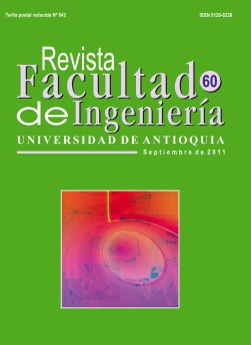Comparative study for chaotic behaviour in fire fighting robot
DOI:
https://doi.org/10.17533/udea.redin.13653Keywords:
fire fighting, mobile robots, non linear, chaosAbstract
The fire fighting monitoring work is a case study where the chaotic control could minimize human, material and environmental injuries. In this paper, we proposed a chaotic control for a mobile robot, in order to do a further inspection in regular spaces, moving it through time with non determinate trajectories. A chaotic nature in the mobile vehicle is added, putting together kinematics with non linear equations such as Arnold and Lorenz, in the same system.
Downloads
References
M. Y. H. Bangash, T. Bangash. “Explosion-Resistant Buildings”. Ed. Springer Verlag. Londres. 2006. pp. 46-52.
H. Amano. “Present Status and Problems of Fire Fighting Robots”. Proceedings of the 41st SICE Annual Conference SICE 2002. Vol. 2. 2002. pp. 880-885.
Y. Kanayama, Y. Kimura, F. Miyazaki, T. Noguchi. “A Stable Tracking Control Method for an Autonomus Mobile Robot”. Proceedings of the 1990 IEEE International Conference on Robotics and Automation. Vol. 2. 1990. pp. 384-389.
V. Muñoz, A. Ollero, M. Prado, A. Simón. “Mobile Robot Trajectory Planning with Dynamics and Kinematics Constraints”. Proceedings of the IEEE International Conference on Robotics and Automation. Vol. 4. 1994. pp. 2802-2807.
Y. Nakamura, A. Sekiguchi. “The Chaotic Móbile Robot”. IEEE Transactions on Robotics and Automation. Vol.17. 2001. pp. 898-904. DOI: https://doi.org/10.1109/70.976022
M. Savi. “Dinâmica Não-Linear e Caos”. Ed. e-paper. Rio de Janeiro. Brasil. 2006. pp. 75-97.
J. M. T. Thompson, H. B. Stewart. Nonlinear Dynamics and Chaos. Ed. John Whiley and Sons. Great Britain. 1996. pp. 291-347.
A. Astari, G. Thomas, W. Kinsner. “Sufficient Conditions for Chaotic Maps to Yield Chaotic Behavior after FM”. IEEE Transactions on Aerospace and Electronic Systems. Vol. 44. 2008. pp. 1240-1248. DOI: https://doi.org/10.1109/TAES.2008.4655379
K. M. Cuorno, A. V. Oppenheim, S. H. Strogatz. “Synchronization of Lorenz-Based Chaotic Circuits with Applications to Communications”. IEEE Transactions on Circuits and Systems II. Analog and Digital Signal Processing. Vol. 40. 1993. pp. 626-633. DOI: https://doi.org/10.1109/82.246163
J. Determan, J. A. Foster. “Using Chaos in Genetic Algorithms”. Proceedings 1999 Congress on Evolutionary Computation CEC 99. Vol. 3. 1999. pp. 2094-2101.
Y. Wang, L. Wang, S. YU, L. Zhang, D. Yan, Y. Li. Method of Chaotic Pulse Sequence Produced by Continuous Chaotic System. 9th International Conference on Proceedings Signal Processing. ICSP 2008. IEEE Conferences. 2008. pp. 1892-1895.
J. A. Maldonado, J. A Hernandez. Chaos Theory Applied to Communications. Part I: Chaos Generators. “Fourth Congress of Electronics, Robotics, and Automotive Mechanics, IEEE Computer Society”. Morelos. México. 2007. pp. 50-55. DOI: https://doi.org/10.1109/CERMA.2007.4367660
L. M. Pecora, T. L. Carroll. “Driving systems with chaotic signals”. The American Physical Society. Vol. 44. 1991. pp. 2374-2384. DOI: https://doi.org/10.1103/PhysRevA.44.2374
D. Drysdale. An Introduction to Fire Dynamics. 2a . ed. Ed. Jhon Wiley & Sons. Edinburgh. UK. 1999. pp. 1-29.
J. Jones, A. Flynn, B. Seiger. Mobile Robots, Inspiration to implementation. 2a . ed. Ed. AK Peters. USA. 1993. pp. 11-37.
J. C. Alexander, J. H. Maddocks. “On the Kinenatics of Wheeled Mobile Robots”. International Journal Robot Vehicles. Vol. 8. 1989. pp. 15-27. DOI: https://doi.org/10.1177/027836498900800502
O. Lengerke, M. S. Dutra, F. M. G. França, M. J. M. Tavera. “Automated Guided Vehicles (AGV): Searching a Path in the Flexible Manufacturing Systems”. Journal of Konbin. Vol. 8. 2008. pp. 113- 124. DOI: https://doi.org/10.2478/v10040-008-0106-7
Downloads
Published
How to Cite
Issue
Section
License
Copyright (c) 2018 Revista Facultad de Ingeniería

This work is licensed under a Creative Commons Attribution-NonCommercial-ShareAlike 4.0 International License.
Revista Facultad de Ingeniería, Universidad de Antioquia is licensed under the Creative Commons Attribution BY-NC-SA 4.0 license. https://creativecommons.org/licenses/by-nc-sa/4.0/deed.en
You are free to:
Share — copy and redistribute the material in any medium or format
Adapt — remix, transform, and build upon the material
Under the following terms:
Attribution — You must give appropriate credit, provide a link to the license, and indicate if changes were made. You may do so in any reasonable manner, but not in any way that suggests the licensor endorses you or your use.
NonCommercial — You may not use the material for commercial purposes.
ShareAlike — If you remix, transform, or build upon the material, you must distribute your contributions under the same license as the original.
The material published in the journal can be distributed, copied and exhibited by third parties if the respective credits are given to the journal. No commercial benefit can be obtained and derivative works must be under the same license terms as the original work.










 Twitter
Twitter